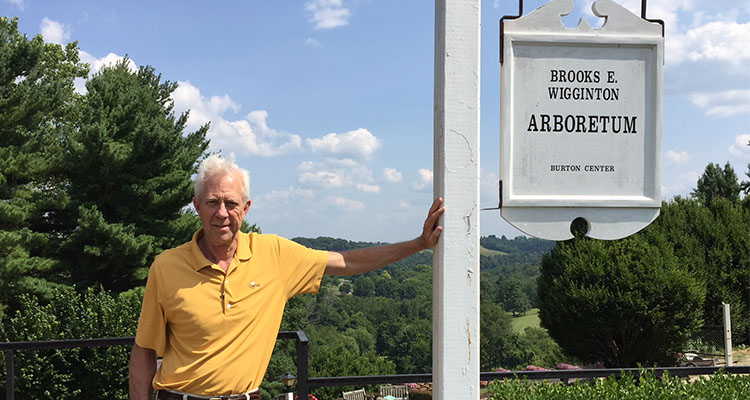“It gives me chills thinking about Brooks.”
Andy Barger stood — as tall as a small tree at 6-foot-4 — near the “Brooks E. Wigginton Arboretum” sign on the hilltop, overlooking trees and flower plantings and walkways, reflecting on the past and surveying the sweeping landscape ahead. The Oglebay Hilltop. Wigginton preceded Barger as the park’s landscape architect — the only two in Oglebay’s 90-year history.
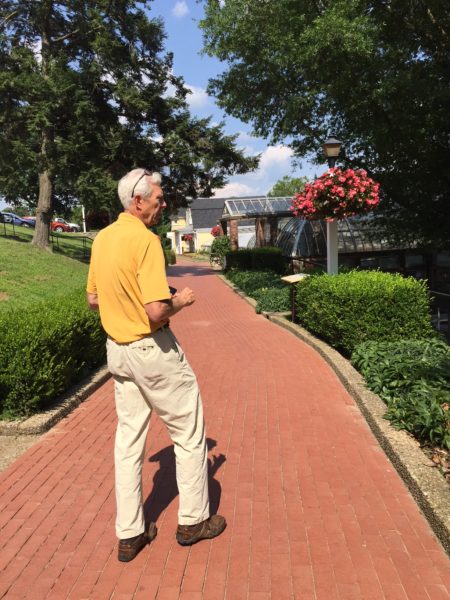
“That’s a Norway maple. That’s a white pine. That’s a little filbert down there,” he said pointing to the hillside below us. “And all kinds of oaks.”
The sugar maple is probably his favorite, with the “nicest fall colors.” There’s an amur cork tree, near the fountain at the Hilltop. Probably no one has a clue what that is, he says.
But Barger does. He knows them all. After 40 years in the landscape architecture business with Oglebay Park, he’s planted hundreds of trees to keep Oglebay Park, well, “park-like.”
Trees … that’s what “makes a park a park,” he said.
Barger started work as a landscape architect officially 37 years ago but worked with Oglebay for 40 years. And he’s only the second landscape architect at the park, the first being Brooks E. Wigginton, who retired around the late 1980s or early ’90s.
A 1970 Triadelphia High School graduate, Barger retired last month.
Did he always want to be a landscape architect?
“That’s a whole ‘nother’ story,” he laughed.
After Barger’s sophomore year at Potomac State College, he moved to Florida with some buddies. He didn’t have a major, and he just didn’t know what he wanted to do. While in Florida, his job entailed treating housing developments for termites. The lush plantings at the homes fascinated him.
Barger had never heard of landscape architecture as a profession. When he looked into it, he discovered a program at West Virginia University. So, after 11 months in Florida, he returned to his home state and went back to school.
“I met Brooks when I was a junior in college,” Barger recalls. Barger worked for landscaper Ray Teater, who had a little nursery just beyond the park. “My senior year, I did my senior project on the Good Zoo; it was under construction at the time, and I spent a lot of time with Brooks going over his plans, his designs, and we just sort of hit it off. I can’t explain it. And he asked me if I would work with him on a couple of things, helping him with the legwork, taking measurements, going out and suggesting plants and that kind of stuff, just giving him some help.”
Barger looks back fondly on what he learned from Wigginton. “… There’s just so many things.”
“The most important thing as a designer that I picked up from working with Brooks is attention to detail and attention to scale. When I say scale, I’m talking about anything from the size of plant beds to structures. … He was a very, very, very patient person, and when he had to express something to you that he didn’t feel that you were quite getting, he just had a marvelous way of communicating without making you feel like you totally didn’t know anything. He was just a wonderful, wonderful man.”
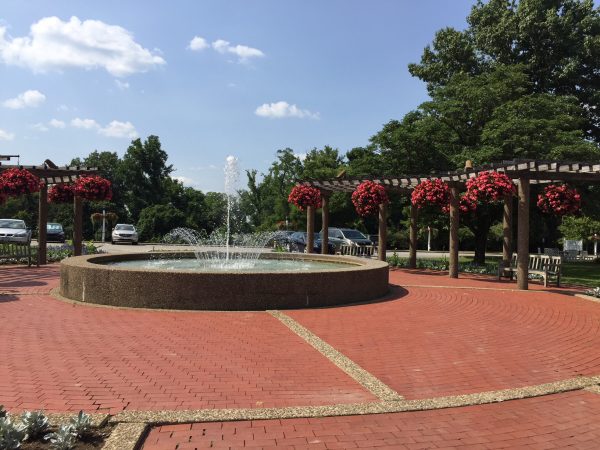
Wigginton’s daughter Heidi Friend recalls the relationship between the two.
“After Dad retired from Oglebay, he remained in close contact with Andy,” said Friend. “Andy would bring landscape plans to the house, and he and Dad would spend ‘board time’ reviewing proposed designs and plant materials. Trading news and ideas, they enjoyed each other’s company.
“The parks were fortunate to have Andy Barger follow in Dad’s footsteps. I know that Dad was pleased to have Andy to mentor and pass on his passion for Oglebay and Wheeling parks,” Friend said.
Besides Wigginton, Barger attributes much as his career success to Randy Worls (Oglebay Foundation chairman emeritus with a 64-year history with the parks) and to Doug Dalby (who served as CEO at the park for around 30 years).
“I met Randy Worls through Brooks, and that was another association that developed. I have so many people to thank for my career here. Brooks, Randy Worls, Doug Dalby were the key people in my longevity here as a landscape architect. Their trust in me has always been wonderful, and I’ve always appreciated it. Those three guys really made my career.”
Said Worls, “The beauty of these parks is due to the skills of Brooks Wigginton. … And it was followed up by Andy Barger, who was basically his student, then took over. The two of them are responsible for what you see in the park.”
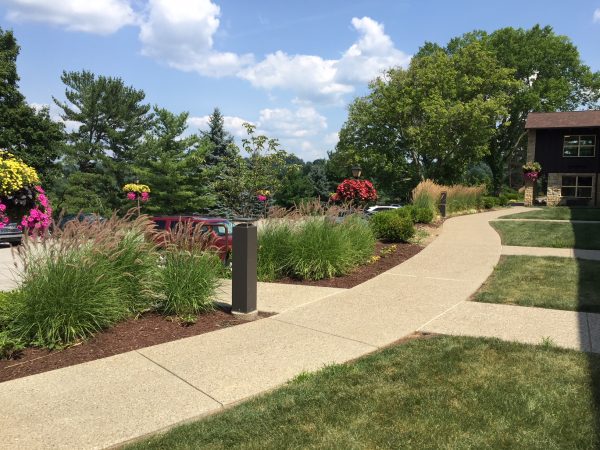
“You know I’d say I’ve had a really good working relationship with Chris Schenkel over the years … Chris is another one of those guys I’d lump in with Randy, Doug, Brooks. … Chris [a horticulturist] is really good at what he does,” Barger said, while looking at The Hilltop at Oglebay.
The development of The Hilltop was probably Barger’s biggest project, the one that gives him the most joy, he said.
“I see people enjoying it, walking it … it’s a wonderful spot,” he said.
“I designed the fountain that we have there, the brick walkways, some of the little spaces outside the mansion. … That was a huge job. And then in conjunction, I worked closely with Chris Schenkel on that for developing the flowerbed spaces. I don’t pick the flowers — that’s Chris. I just designed the areas where the flowers would go.”
He won’t use the word “legacy” in regard to the project.
But Eriks Janelsins, president of the Oglebay Foundation, will.
“This is now known as the best garden in the state of West Virginia,” Janelsins said. “… Other places build those gardens, and they’d be like a zoo that you pay admission. We build them as an enhancement to the experience. It’s free. … We have people who walk this three times a day. … It’s the connection to the history and the heritage and the Oglebay family and how much they loved plants and agriculture and history and to be able to continue that. …”
That’s “legacy.”
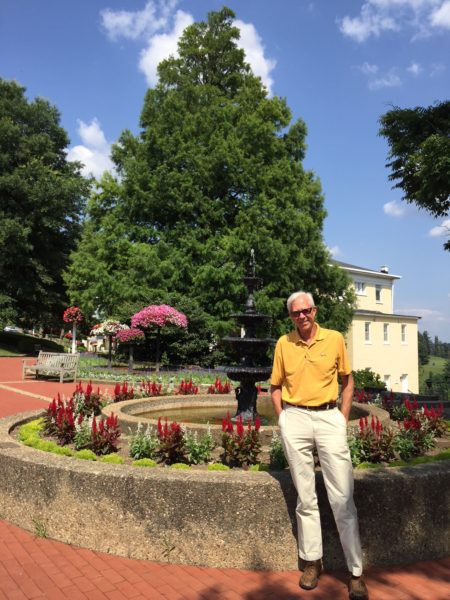
Barger has selected and planted hundreds of trees over the last 40 years, specifically staking out where they go, which he says is “the second aspect of my job that I’ve most enjoyed over the years.”
But ever so humble, Barger added, “I’m fortunate that the [Wheeling] Park Commission has supported all the planting. … They were always behind keeping the park park-like, very adamant about keeping the tree collection ongoing.”
While Barger won’t talk about his own legacy, he will talk about Wigginton’s.
“He had a very long-range vision. When he came here, there was very little as far as development in a lot of areas. He was brought in to do the arboretum. That was the reason he first came here. From there, he developed a lot of different areas. A lot of cottage sites, the lodge as it grew, Brooks did a lot of the site work. Brooks did a lot of the site work for all our newer buildings. He liked to joke that he came for a job that he … how did he put it? … He was fortunate enough to come in for a job that should’ve taken a year or less and stretched it to 40. He did a lot of tree planting as well.”
“I think one of the keys to Brooks Wigginton’s original design and an element that Andy continued was to hide the buildings of the park into the landscape,” Janelsins noted.
“For a park, Oglebay has numerous buildings and structures. But many of those buildings are made less obtrusive through their planning and understanding of landscapes.”
In the last 10 years, Barger’s job evolved beyond the realm of landscape architecture at the park, and he became Director of Planning. He conceived plans for Americans Disabilities Act (ADA)-compliant restrooms and worked on other ADA issues, as well as plans for a couple of the park shelters. He’s been liaison over the years for many grants the park has received from the Land and Water Conservation Fund. He’s been involved with the Festival of Lights, designing some of the displays.
A temporary sculpture garden near the park’s main offices was a brainchild of Barger’s in 2017.
“I had a stopover in Puerto Rico and was walking through Old Town, and they had little pockets of sculpture throughout. … I’ve seen it in other areas. … Our gardens are the perfect setting. Not a revenue thing, but just something that would be awfully nice to see, for what I think is very little money. We were able to get 16 pieces from various sculptors from West Virginia, Ohio and Pennsylvania, … for a very popular exhibit. It was really nice. We got a lot of nice comments on it.”
The commissioners purchased one of the pieces, a heron created by Wheeling artist Jeff Forster. The heron rests on a tree branch, above the steps to the Anne Kuchinka Amphitheatre.
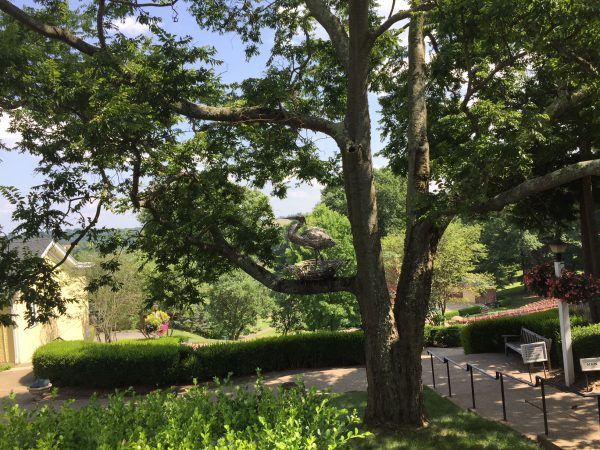
That heron and hundreds of trees stand testament to Barger’s 40-year career.
“Andy’s vision is everywhere we look at Oglebay today. From the placement of trees that will stand for generations, to the design of the Bissonnette Gardens, to the location and site of Oglebay’s favorite new cottages and estate houses, to the Festival of Lights displays. For the last 40 years, Andy has established the landscaping standard at Oglebay that is recognized instantly as one of the country’s top parks,” Janelsins said.
“The Oglebay family planted more than 352,000 trees in Oglebay and the surrounding countryside. It’s amazing to me that today we enjoy the shade of trees planted by Mr. Oglebay, or we climb in the big London plain trees Mr. Oglebay loved and planted around the dairy silo (now the Aerial Adventure Course). … In 90 years, how will Wheeling residents enjoy the trees that Andy planted?”
One of the trees Barger planted replaced a more than 150-year-old white oak near the Mansion, one that would’ve preceded the Oglebays.
That white oak was Barger’s favorite tree in the park. “It was just so majestic when mature. I was very sad to lose it.
And probably many at Oglebay feel the same way about Barger’s departure.
“It goes without saying how much I love this place. I really feel it’s a huge part of my life. I’m retiring, but I’m not leaving. I’m going to be in the park, walking — I use the park. I’ve also told the administration that if there’s something that comes up, I’ll be around.”
(Photos by Phyllis Sigal)
• After nearly 38 years as reporter, bureau chief, lifestyles editor and managing editor at The Times Leader, and design editor at The Intelligencer and Wheeling News-Register, Phyllis Sigal has joined Weelunk as managing editor. She lives in Wheeling with her husband Bruce Wheeler. Along with their two children, son-in-law and two grandchildren, food, wine, travel, theater and music are close to their hearts.



